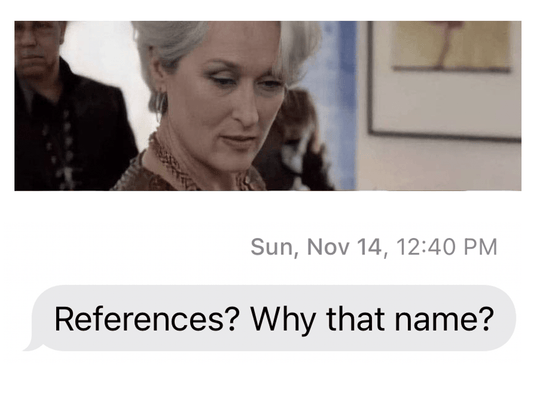Reading experience disclaimer: our blog posts contain annotations that are often more interesting than the content itself. On your phone, annotations will show up in between paragraphs. On larger screens, you’ll see them on your right, next to the paragraph they’re meant to expand upon. All footnote numbers are clickable and lead to the corresponding annotations.
We sent this shortlist of 50ish people an open invitation: gather all the clothes + fabrics you don’t want anymore, and we’ll give you the full References experience:
👉 We’ll pick up everything from your door, whenever works with your schedule—no contact necessary. (Again: this is early 2021 i.e. pre-vax szn.)
👉 We’ll take any brand, fancy or not, and any number of items, from just a bag to a full move-out decluttering extravaganza.
👉 We’ll sort & analyze everything and we’ll make sure that each piece, regardless of its condition, will live its best afterlife and have the best possible chance to avoid the landfill2 by exploring all possible routes—
Fabric recycling that’s not based on shipping bales of largely unwearable clothes to poorer countries.
Repair & care for quality donations to local communities, based on their actual demand, not through anything-goes Goodwill & Salvation Army dumps.
Upcycling via donations to independent fashion designers who rework old textiles into new fashion.5
Downcycling through working with local businesses that need fabric for industrial uses.
The overthinker’s approach to fashion recycling, we called it.
Big nerd energy but make it fashun.
[Speaking of nerdy things, a quick pause here to note: at that point we were operating under the project name STRING NYC. The idea had its origins to the Greek myth of Ariadne and her famous ball of thread6 but that’s a story for another post. Anyway. After launching & running the pilot as STRING NYC we had let’s say a little change of heart also known as discovering this… and, long story short: now we’re References!]
So.
Re: how the pilot went—
✅ We drove from Long Island to the Jersey Shore and everywhere in between.
✅ We picked up a total of 2,204 pieces of clothing, shoes, accessories, but also bed sheets, bath towels, curtains, small rugs, and so many other fabrics—including 33 pounds of clothes from the nonprofit org NYC Mammas Give Back8 which had plenty of unwearable leftovers9 to recycle.
✅ We sorted, cleaned, and analyzed all of them to determine their best next life. Think a fashion enthusiast’s understanding of clothes, translated into an algorithmic methodology—and then tested x 2,204 with every single piece, from the mint-condition Margielas to the old Nike socks.10
✅ We gave everyone their $ payouts—an average of over $100 for each of our pilots participants.
✅ We had calls with fabric recycling pros, we made trips to literally all the big-chain thrift stores in the city plus some neighborhood favorites, we connected with small, grassroots nonprofits who are doing wonders for their communities, we spoke to fashion designers, sustainability consultants, luxury resale account managers, wardrobe organizers, retail store managers, sustainable dry-cleaners, shoe cobblers, and many others—all, so that we can figure out what to do with the first piles of stuff 11 we had collected.
✅ We reported back to our pilot participants with reports and references about where in the ecosystem their clothes were distributed to so that they know what happens.
As it happens, a lot changed after and because of what we learned during the pilot. Back to that Ariadne/Theseus reference ^^^ we went into it expecting a labyrinth type of experience—and it sure was: what happens to the clothes we’re done with for whatever reason (gained/lost weight, changed styles, bored of it, never wear it, over-worn it, accidentally destroyed it, etc. etc.) is somewhat counter-intuitively a question with wildly different answers depending on who in the secondhand ecosystem you ask and their own biases.
Not that we’re complaining. At the end of the day, the driving force behind this project is exactly that WTH of it all—post-pilot & well into the fashion-recycling maze now, we may not have that Ariadne string but you know what? We have references 🤗
1. As the NYT reported: “With selling now moved to appointment only at most of these stores, with a 40-to-50-piece limit on the number of items sellers can bring in, friction on both sides of the exchange has been lessened.”
3. Interesting story re: resale—by Highsnobiety.
4. From The Fashion Law: “Due to the sheer volume of donated clothing in the U.S., most of these wares (…) are shipped to Africa, India, Pakistan, and other far-flung locales, where they are sold to traders, who will then sell them to consumers.”
5. We didn’t work with (young designer) Alexandra Armata but her 30 Jeans/30 Days project is a great visual case study about what’s possible when the right person gets their hands on old clothes.

6. Ariadne’s Thread is the story of how badass Ariadne helped toxic male/Hercules-wannabe Theseus come out of a complicated maze alive using just a ball of thread—or, string. The experience of researching fashion + recycling felt to us at the time a lot like navigating a labyrinth in need of a simple-but-genius solution. Hence,

7. The donations-eligible clothing from our pilot went specifically to the NYC-based organizations Astoria Values, Room to Grow, NYC Mammas Give Back, Bottomless Closet, BronxWorks, Urban Pathways, and Ujima Community Working Together.
8. A NYC-based nonprofit which supports mothers & families in need, here in the five boroughs. Here’s more info about our work with them.
9. Poor-quality donated clothing—a result of the perception that *someone* will benefit from our clothing waste—is why nonprofits often hear “clothing donations” and are like “TYVM but no.”
10. For those wondering, the strangest thing we got was a nurse costume with branding from the Netflix show Maniac.
11.





